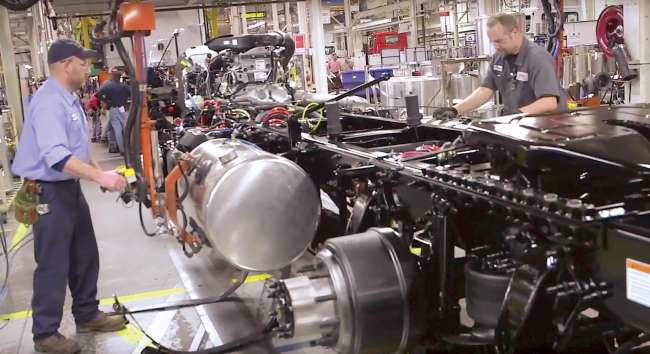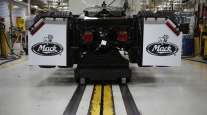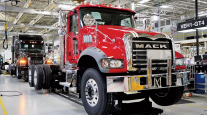Class 8 Orders Post Strong Gain in November

North American Class 8 orders in November reached nearly 33,000 for a 69% year-over-year gain, ACT Research Co. reported, but incentives and an uneven order pattern in the market have some concerned.
Preliminary net orders were 32,900 compared with 19,440 a year earlier. ACT will revise the total when truck makers report final volumes later in the month.
Also, November’s volume marked the second-best order month since January 2015, when orders reached 35,283.
Freight continues to grow and capacity continues to tighten, ACT Vice President Steve Tam told Transport Topics. Also, rates have skyrocketed, especially in the spot market.
“Quite frankly, orders did what we thought they were going to do, maybe a little bit better,” he said.
OEMs are discounting in an up market. So you have strong demand for your product, but that’s the game that we are playing.
Steve Tam, ACT Research Co. vice president
However, he said truck makers continue to incentivize the market for fleets of all sizes.
“It starts off like one hole in the dike,” Tam said. “One [original equipment manufacturer] chooses to do it as a competitive strategy to try and gain market share. The others are forced to make a decision; do they play or do they pass? And they are all playing, to a company.”
Tam considers the approach incongruous and dysfunctional because this is occurring as the industry moves from an overcapacity of trucks to a position of balance.
“OEMs are discounting in an up market. So you have strong demand for your product, but that’s the game that we are playing” with trucks equipped with improved safety features and offering better fuel mileage — and now at lower prices, he said.
ACT forecasts North American Class 8 production to land at 255,886 units in 2017 and 321,866 in 2018.
Research company FTR pegged preliminary net orders at 32,400 units.
“My forecast was 32,000 units,” said Don Ake, FTR’s vice president of commercial vehicles.
Ake remains concerned (as he was with October’s orders) that the distribution among the original equipment makers remains unequal, which he described as an indication things may not be as great as the order numbers indicate.

“It is still not normal. If it was general strength, then all the OEMs should have been showing a certain amount of strength,” he said. “Everyone should be moving forward briskly. Some are moving very fast, and others are still moving forward since it is order season, but not as much.”
Asked if it could just be the market making choices, Ake said, “You could look at it that way. But it is hard to see those customer choices short term.”
He said he could not discuss the details of which OEMs were lagging.
However, WardsAuto.com tracks U.S. Class 8 retail sales, which reflect earlier orders. In October, the two lowest market shares among OEMs — selling more than 1,000 trucks in the month — were posted by Mack Trucks, 5.9%, and Volvo Trucks North America, 8.4%.
Mack and VTNA are brands of Volvo Group.
One analyst said his recent survey of Freightliner dealers pointed to ongoing vocational demand as well as fleet orders for new model year trucks — and also revealed diverse order expectations among those dealers. DTNA’s Freightliner is the U.S. heavy-duty market’s leading brand.
“Approximately 56% of contacts reported that new Class 8 truck orders are exceeding their expectations thus far in [the fourth quarter], 24% cited that orders were on par with their expectations for this quarter, and the remaining 20% of dealers reported that orders were below expectations,” Neil Frohnapple, director of equity research at The Buckingham Research Group, wrote in a note to investors.
Also, the lead time for a vocational truck from Freightliner is about 90 days, he said. For a sleeper, it is about 75 days, Frohnapple reported.
Another analyst reacted favorably to the order volume in November.
“Upside is coming through as fundamentals for freight haulers continue to track favorably, including larger-than-expected gains in core pricing and an earlier-than-expected return of positive used-equipment pricing (both relative to our expectations),” R.W. Baird & Co. analyst David Leiker wrote in a note to investors.
Meanwhile, December always is the biggest order month, but the question is how will December fare with two bigger-than-expected months already landing in the quarter, Tam said.
October’s final net volume was 36,033.
Buyers ordered 21,386 trucks in December 2016, according to ACT.
Ake said he is forecasting orders will reach 30,000 in December.





